Passion is a frequent theme in Seth Godin’s latest book, Linchpin. He also spends a good bit of time on discernment. The ability to see things they way they really are. Each corner of the illustration below represents a different kind of per and the way he responds to situations at work.
“In the bottom right is the Fundamentalist Zealot. He is attached to the world as he sees it. There is no prajna her, no discernment. Change is a threat. Curiosity is a threat. Competition is a threat. As a result, it’s difficult for him to see the world as it is,because he insists on the the world being the way he imagines it. At the same time, he has huge reservoirs of effort to invest in maintaining his worldview. Fundamentalist zealots always manage to make the world smaller, poorer, and meaner.
The top left belongs to the Bureaucrat. He’s certainly not attached to the outcome of events, and he definitely won’t be exerting any additional effort,regardless. The bureaucrat is a passionless rules follower, indifferent to external events and gliding through the day. The clear at the post office and the exhausted VP at General Motors are both bureaucrats.
The bottom left is the corner for the Whiner. The whiner has no passion, but is extremely attached to the worldview he’s bought into. Living life in fear of change, the whiner can’t muster the effort to make things better,but is extremely focused on wishing that things stay as they are. I’d put most people int he newspaper industry in this corner. They stood by for years, watching the industry crumble while they resolutely did nothing except whine about unfairness. Almost all the positive change in this industry (like The Huffington Post and YouTube) is coming from outsiders.
And that leaves the top right, the quadrant of the Linchpin. The linchpin is enlightened enough to see the world as it is, to understand that this angry customer is not about me, that this change in government policy is not a personal attack,that this job is not guaranteed for life. At the same time, the linchpin brings passion to the job. She knows from experience that the right effort in the right place can change the outcome, and she reserves her effort for doing just that.
Here’s another way to describe the two axes: One asks, Can you see it? The other wonders, Do you care?


I would encourage you to read the book before making a final judgment on that one page. More context would be useful.
Having said that, why not strive to stay in Linchpin quadrant all the time?
I’m not sure I like this graph. Don’t you think we roll around each section at different times?